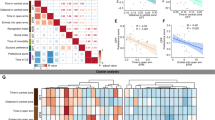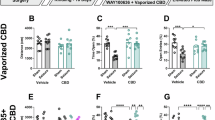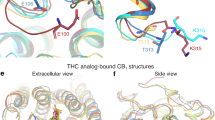Abstract
We investigated the effect of low doses of intraperitoneal Δ9-tetrahydrocannabinol (THC) on anxiety behavior in rats using the elevated plus maze (EPM). An anxiolytic effect was obtained in a range of doses between 0.075 and 1.5 mg/kg, the 0.75 dose being the most effective. Pretreatment with the CB1 receptor antagonist AM251 fully reversed THC's effect, suggesting CB1 receptors were involved. In order to elucidate the neuroanatomical substrates underlying the effect of the maximal effective dose of THC, we investigated cFos expression in anxiety-related brain regions (prefrontal cortex, nucleus accumbens, amygdala, and hippocampus) of rats exposed to the EPM. THC significantly lowered the amount of cFos in prefrontal cortex and amygdala without affecting the other cerebral areas. As there is increasing evidence that CREB function regulates anxiety-like behavior in rats, the second biochemical parameter we measured was phosphorylated CREB in the same brain areas. Rats treated with THC showed a significant increase in CREB activation in the prefrontal cortex and hippocampus. In the prefrontal cortex this increased activation was linked to an increase in ERK activation, whereas in the hippocampus there was a drop in the activity of CAMKII, a kinase with inhibitory effect on CREB activation. All these effects were reversed by AM251 pretreatment, suggesting that stimulation of CB1 receptors is fundamental for triggering the biochemical events. Our results suggest that the stimulation of these receptors in the prefrontal cortex, amygdala, and hippocampus with the subsequent activation of different signaling pathways is the first event underlying the effects of cannabinoids on anxious states.
Similar content being viewed by others
Log in or create a free account to read this content
Gain free access to this article, as well as selected content from this journal and more on nature.com
or
References
Amaral DG, Price JL, Pitkanen A, Carmichael ST (1992). Anatomical organization of the primate amygdaloid complex. In: Aggleton JP (ed). The Amygdala: Neurobiological Aspects of Emotion, Memory and Mental Dysfunction. Wiley-Liss: New York. pp 1–66.
Arevalo C, de Miguel R, Hernandez-Tristan R (2001). Cannabinoid effects on anxiety-related behaviours and hypothalamic neurotransmitters. Pharmacol Biochem Behav 70: 123–131.
Atkins CM, Selcher JC, Petraitis JJ, Trzaskos JM, Sweatt JD (1998). The MAPK cascade is required for mammalian associative learning. Nat Neurosci 1: 602–609.
Barrot M, Olivier JD, Perrotti LI, DiLeone RJ, Berton O, Eisch AJ et al (2002). CREB activity in the nucleus accumbens shell controls gating of behavioral responses to emotional stimuli. Proc Natl Acad Sci USA 99: 11435–11440.
Barrot M, Wallace DL, Bolanos CA, Graham DL, Perrotti LI, Neve RL et al (2005). Regulation of anxiety and initiation of sexual behavior by CREB in the nucleus accumbens. Proc Natl Acad Sci USA 102: 8357–8362.
Berrendero F, Maldonado R (2002). Involvement of the opioid system in the anxiolytic-like effects induced by Δ9-tetrahydrocannabinol. Psychopharmacology 163: 111–117.
Bortolato M, Campolongo P, Mangieri RA, Scattoni ML, Frau R, Trezza V et al (2006). Anxiolytic-like properties of the anandamine transport. Inhibitor AM404. Neuropsycopharmacology 31: 2652–2659.
Braida D, Iosuè S, Pegorini S, Sala M (2004). Delta 9-tetrahydrocannabinol-induced conditioned place preference and intracerebroventricular self-administration in rats. Eur J Pharmacol 506: 63–69.
Braida D, Sala M (2000). Cannabinoid-induced working memory impairment is reversed by a second generation cholinesterase inhibitor in rats. Neuroreport 11: 2025–2029.
Branchi I, D'Andrea I, Sietzema J, Fiore M, Di Fausto V, Aloe L et al (2006). Early social enrichment augments adult hippocampal BDNF levels and survival of BrdU-positive cells while increasing anxiety- and ‘depression’-like behavior. J Neurosci Res 83: 965–973.
Carlezon Jr WA, Duman RS, Nestler EJ (2005). The many faces of CREB. Trends Neurosci 28: 436–445.
Davidson RJ (2002). Anxiety and affective style: role of prefrontal cortex and amigdala. Biol Psychiatry 51: 68–80.
Duncan GE, Knapp DJ, Breese GR (1996). Neuroanatomical characterization of c-fos induction in rat behavioral models of anxiety. Brain Res 713: 79–91.
Genn RF, Tucci S, Marco EM, Viveros MP, File SE (2004). Unconditioned and conditioned anxiogenic effects of the cannabinoid receptor agonist CP 55,940 in the social interaction test. Pharmacol Biochem Behav 77: 567–573.
Hampson RE, Evans GJ, Mu J, Zhuang SY, King VC, Childers SR et al (1995). Role of cyclic AMP dependent protein kinase in cannabinoid receptor modulation of potassium ‘A-current’ in cultured rat hippocampal neurons. Life Sci 56: 2081–2088.
Heffner TG, Hartman JA, Seiden LS (1980). A rapid method for the regional dissection of the rat brain. Pharmacol Biochem Behav 13: 453–456.
Heilig M (2004). The NPY system in stress, anxiety and depression. Neuropeptides 38: 213–224.
Hinks GL, Brown P, Field M, Poat JA, Hughes J (1996). The anxiolytics CI-988 and chlordiazepoxide fail to reduce immediate early gene mRNA stimulation following exposure to the rat elevated X-maze. Eur J Pharmacol 312: 153–161.
Hogg S (1996). A review of the validity and variability of the elevated plus-maze as an animal model of anxiety. Pharmacol Biochem Behav 54: 21–30.
Howlett AC, Mukhopadhyay S (2000). Cellular signal transduction by anandamide and 2-arachidonoylglycerol. Chem Phys Lipids 108: 53–70.
Iversen L (2003). Cannabis and the brain. Brain 126: 1252–1270.
Kathuria S, Gaetani S, Fegley D, Valino F, Duranti A, Tontini A et al (2003). Modulation of anxiety through blockade of anandamide hydrolysis. Nat Med 9: 76–81.
Kovacs KJ (1998). c-Fos as a transcription factor: a stressful (re)view from a functional map. Neurochem Int 33: 287–297.
Likhtik E, Pelletier JG, Paz R, Pare D (2005). Prefrontal control of the amygdala. J Neurosci 25: 7429–7437.
Lister RG (1987). The use of a plus-maze to measure anxiety in the mouse. Psychopharmacology (Berl) 92: 180–185.
Marco EM, Perez-Alvarez L, Borcel E, Rubio M, Guaza C, Ambrosio E et al (2004). Involvement of 5-HT1A receptors in behavioural effects of the cannabinoid receptor agonist CP 55,940 in male rats. Behav Pharmacol 15: 21–27.
Marin S, Marco E, Biscaia M, Fernandez B, Rubio M, Guaza C et al (2003). Involvement of the kappa-opioid receptor in the anxiogenic-like effect of CP 55 940 in male rats. Pharmacol Biochem Behav 74: 649–656.
McGregor IS, Hargreaves G, Apfelbach R, Hunt GE (2004). Neuronal correlates of cat odr-induced anxiety in rats: region-specific effects of the benzodiazepine midazolam. J Neuroscince 24: 4134–4144.
McNaughton N, Gray JA (2000). Anxiolytic action on the behavioural inhibition system implies multiple types of arousal contribute to anxiety. J Affect Disord 61: 161–176.
Onaivi ES, Green MR, Martin BR (1990). Pharmacological characterization of cannabinoids in the elevated plus maze. J Pharmacol Exp Ther 253: 1002–1009.
Pandey SC (2003). Anxiety and alcohol abuse disorders: a common role for CREB and its target, the neuropeptide Y gene. Trends Pharmacol Sci 24: 456–460.
Pandey SC, Zhang H, Roy A, Xu T (2005). Deficits in amygdaloid cAMP-responsive element-binding protein signaling play a role in genetic predisposition to anxiety and alcoholism. J Clin Invest 115: 2762–2773.
Patel S, Hillard CJ (2006). Pharmacological evaluation of cannabinoid receptor ligands in a mouse model of anxiety: further evidence for an anxiolytic role for endogenous cannabinoid signaling. J Pharmacol Exp Ther 318: 304–311.
Phelps EA, LeDoux JE (2005). Contributions of the amygdala to emotion processing: from animal models to human behaviour. Neuron 48: 175–187.
Rodriguez de Fonseca F, Rubio P, Menzaghi F, Merlo-Pich E, Rivier J, Koob GF et al (1996). Corticotropin-releasing factor (CRF) antagonist [D-Phe12,Nle21,38,C alpha MeLeu37] CRF attenuates the acute actions of the highly potent cannabinoid receptor agonist HU-210 on defensive-withdrawal behavior in rats. J Pharmacol Exp Ther 276: 56–64.
Rubino T, Forlani G, Vigano D, Zippel R, Parolaro D (2004). Modulation of extracellular signal-regulated kinases cacade by chronic delta 9-tetrahydrocannabinol treatment. Mol Cell Neurosi 25: 355–362.
Rubino T, Vigano D, Massi P, Spinello M, Zagato E, Gianoni G et al (2000). Chronic delta 9-tetrahydrocannabinol treatment increases cAMP levels and cAMP-dependent protein kinase activity in some rat brain regions. Neuropharmacology 39: 1331–1336.
Rubino T, Forlani G, Vigano D, Zippel R, Parolaro D (2005). Ras/ERK signalling in cannabinoid tolerance: from behaviour to cellular aspects. J Neurochem 93: 984–991.
Sanudo-Pena MC, Romero J, Seale GE, Fernandez-Ruiz JJ, Walker JM (2000). Activational role of cannabinoids on movement. Eur J Pharmacol 391: 269–274.
Sulcova E, Mechoulam R, Fride E (1998). Biphasic effects of anandamide. Pharmacol Biochem Behav 59: 347–352.
Valjent E, Mitchell JM, Besson MJ, Caboche J, Maldonado R (2002). Behavioural and biochemical evidence for interactions between Δ9-tetrahydrocannabinol and nicotine. Br J Pharmacol 135: 564–578.
Valjent E, Pages C, Rogard M, Besson MJ, Maldonado R, Caboche J (2001). Delta 9-tetrahydrocannabinol-induced MAPK/ERK and Elk-1 activation in vivo depends on dopaminergic transmission. Eur J Neurosci 14: 342–352.
Viveros MP, Marco EM, File SE (2005). Endocannabinoid system and stress and anxiety responses. Pharmacol Biochem Behav 81: 331–342.
Wu X, McMurray CT (2001). Calmodulin kinase II attenuation of gene transcription by preventing cAMP response element-binding protein (CREB) dimerization and binding of the CREB-binding protein. J Biol Chem 276: 1735–1741.
Acknowledgements
This work was supported by Ministero dell’Istruzione, dell’Università e della Ricerca PRIN2004, and by University of Insubria FAR2005. We are grateful to Judy Baggot for language editing of the manuscript.
Author information
Authors and Affiliations
Corresponding author
Rights and permissions
About this article
Cite this article
Rubino, T., Sala, M., Viganò, D. et al. Cellular Mechanisms Underlying the Anxiolytic Effect of Low Doses of Peripheral Δ9-Tetrahydrocannabinol in Rats. Neuropsychopharmacol 32, 2036–2045 (2007). https://doi.org/10.1038/sj.npp.1301330
Received:
Revised:
Accepted:
Published:
Issue date:
DOI: https://doi.org/10.1038/sj.npp.1301330
Keywords
This article is cited by
-
Fatty Acid Amide Hydrolase and Cannabinoid Receptor Type 1 Genes Regulation is Modulated by Social Isolation in Rats
Neurochemical Research (2024)
-
Increased cannabis intake during the COVID-19 pandemic is associated with worsening of depression symptoms in people with PTSD
BMC Psychiatry (2022)
-
Anxiety and cognitive-related effects of Δ 9-tetrahydrocannabinol (THC) are differentially mediated through distinct GSK-3 vs. Akt-mTOR pathways in the nucleus accumbens of male rats
Psychopharmacology (2022)
-
Cannabinoid Type 1 Receptors in the Basolateral Amygdala Regulate ACPA-Induced Place Preference and Anxiolytic-Like Behaviors
Neurochemical Research (2022)
-
Cannabis, a cause for anxiety? A critical appraisal of the anxiogenic and anxiolytic properties
Journal of Translational Medicine (2020)



